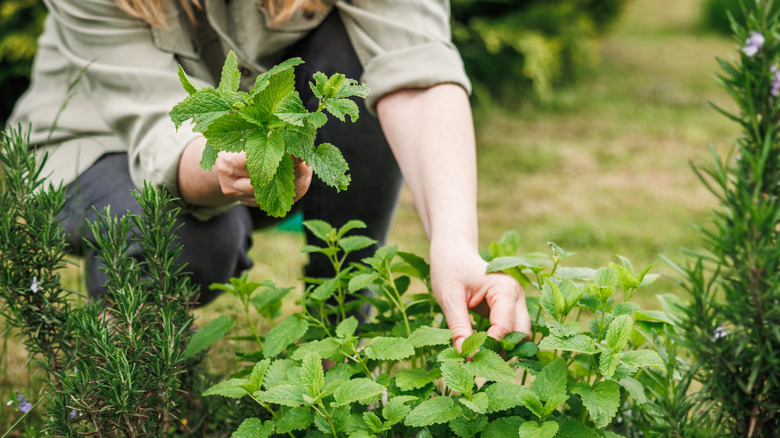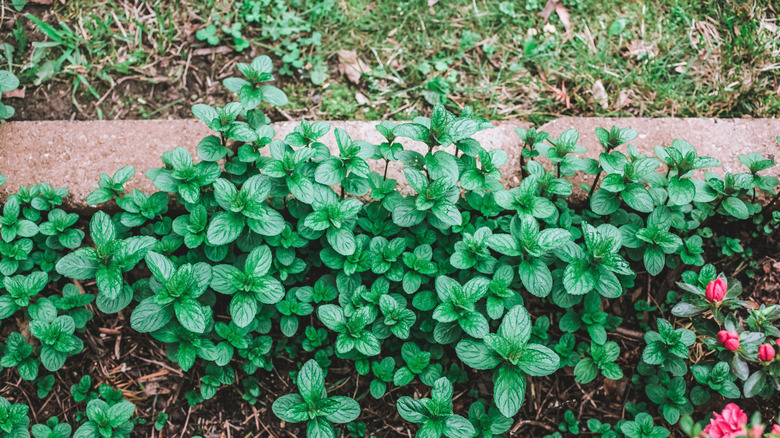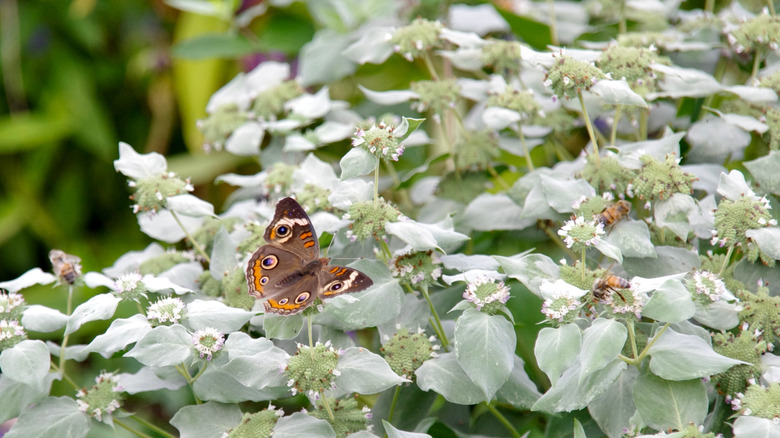Is It Possible To Grow Mint In The Ground? What To Know Before You Try
If you dream of harvesting fresh, minty leaves from your garden to make summery beverages or brighten up a savory or sweet dish, you've probably thought about planting mint right in the ground. The good news for gardeners without much time or experience is that mint is easy to grow. The bad news is that it's a little too easy to grow. So, while it is possible to grow mint in the ground, you should be aware of the consequences.
While you might be envisioning a well-behaved little patch of fresh mint, if you're not careful, your garden bed or lawn could soon be overrun with the herb. Mint (Mentha) refers to a variety of about 20 species of herbs, most of which are known for their distinctive flavors and aromas that add a bright, cooling layer to beverages and food. In your garden, however, one of the most important downsides to growing mint that you should be aware of is its aggressive growth habit.
These herbs can spread so prolifically that many gardening experts strongly recommend not planting mint directly in the ground at all. Instead, they advise you to either grow mint indoors or keep it contained in a pot outside to prevent its roots from escaping into the rest of your garden. If you absolutely need to plant mint directly in the ground, it's important to understand why it's so aggressive and what it will take to keep it under control. Before you start digging, you should also consider alternatives that can achieve similar goals without the same risk of taking over your garden.
Why you probably shouldn't plant mint in the ground
The biggest problem with mint is how easily and quickly it will spread. Plants in this genus spread via rhizomes underground, meaning it can pop up in unexpected parts of your yard. If you're not vigilant about inspecting your lawn and garden beds for stary mint volunteers, you may not notice it's escaped until you've got a sizable new patch of the herb. Along with underground rhizomes, many mints can also spread by runners –- aboveground stems that put down roots wherever they come in contact with soil.
While these will be easier to spot and trim as needed, it still requires consistent pruning to keep those runners from spreading beyond the bed you want your mint to stay in. Even when planted in a container as recommended, roots can still sneak out through the drainage hole, and runners can climb over the edge in search of new soil below. That's why some sources suggest placing containers on a paver or patio to block roots from growing through the drainage holes and into the ground.
In addition to being a prolific spreader, it's also impressively hardy and adaptable. In a perfect world, mint prefers full sun and nutrient-rich soil that's moist, yet well-drained. But it will tolerate some shade and just about any soil type it finds itself in. It's also adaptable to a variety of climates, hardy in USDA zones 4 through 9, and tolerant of both subzero winters and hot summers.
Tips for growing mint without it taking over
You may like the idea of an aggressive spreader to use as a ground cover in a larger area. Even if you want it to spread out, you still need to frequently trim aboveground runners and inspect the rest of your yard for volunteers to keep your ground cover from escaping into other parts of your yard. For added containment, bury a container in the ground and plant your mint in that. This will slow the spread of underground rhizomes, but you'll still need to prune runners often.
Better yet, plant a native mint variety. There are 19 species of mountain mints (Pycnanthemum) belonging to the same family as herbs in the Mentha genus. All of them are native to various parts of North America and tend to boast the same minty aroma and flavor you're probably looking for. So, you'll be able to steep the leaves in your drinks and cook with the herb, just as you would with the non-native mint.
While there may be other varieties of mint that won't try to overrun your garden as aggressively as many, native mountain mints are the safest choice. They're hardy and spread via rhizomes, but they aren't quite as aggressive as their non-native counterparts. So, you get the best of both worlds: a minty fresh plant that can serve as ground cover, but also easy enough to control if you need to keep it more contained. Mountain mint is also a pollinator magnet that will attract beneficial insects to your garden.


